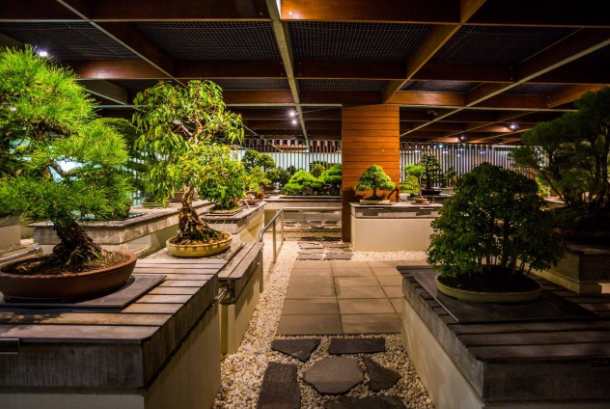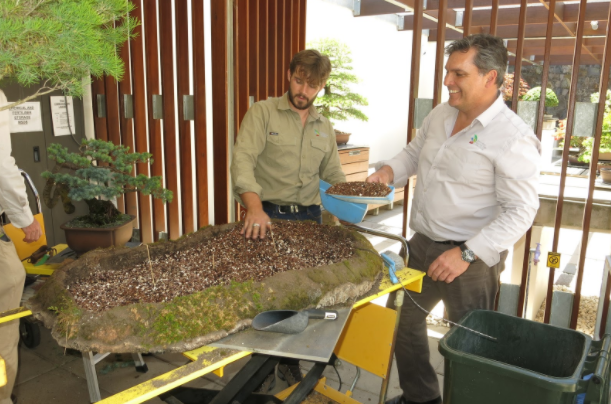The national collection on display in Canberra, Australia. Photos courtesy of Leigh Taafe.
For our next Bonsai Around the World blog, we’re taking you to the land down under.
The National Bonsai & Penjing Collection of Australia is home to 120 bonsai, an amalgamation of donations and loans that have been trained and grown 100 percent by Australian artists. We spoke with Curator Leigh Taafe about his personal connection with bonsai and the development of the bonsai collection in Australia’s capital, Canberra.
Taafe said his journey from a bonsai hobbyist to the top position at the collection kicked off after he watched the original Karate Kid film, which uses bonsai as an archetype for the inner peace and symbol of what karate should be. He opened a commercial bonsai nursery in 2000, running classes and workshops and renting out bonsai to local offices and restaurants for about 13 years.
The main influence on Taafe’s bonsai styling comes from Harry Tomlinson’s Complete Book of Bonsai, which was his sole source of inspiration and information before the internet became a prevalent bonsai resource.
“Once I became a professional I learned to just focus on what I was doing rather than anyone else,” he said. “I am a gatherer of information, but outside of maintenance and techniques, I tried to create my own style.”
Taafe, right, working with Assistant Curator Sam Thompson, left.
In 2010, Taafe officially joined as an assistant curator for three years then rose to the curator position. While the collection technically opened to the public in September 2008, the trees were located on a premise separate from its current location, which was established in 2013 at the National Arboretum in Canberra.
“We started from the ground up,” Taafe said. “We started collecting trees in 2007 for the purpose of a national collection – it wasn’t a collection to begin with.”
The arboretum, which was constructed as a monument to the people and homes lost in brush fires that decimated miles of land in the early 2000s, contains approximately 100 forests as well as gardens, playgrounds and a visitor center. The bonsai display area features about 70 trees ready for show but also a small area for trees undergoing various maintenance stages.
Trees that need to keep warm in the winter, like bougainvillea, are stored in glass with heaters to prevent subzero temperatures at night. Taafe said Canberra temperatures can reach minus 8 degrees Celsius (or about 17 degrees Fahrenheit).
LEFT: A smooth-barked apple (gum tree) native to Australia and nearby islands that dates back to 1959.
RIGHT: The box leaf privet, dating back to 1880.
The displays in the National Bonsai & Penjing Collection are arranged simply in an aesthetic and appealing manner, not limiting trees to areas for specific artists or regions. Every tree has been styled and grown by Australian artists, as Australia imposes strict quarantine requirements for imported goods.
“From the outset we decided the collection was going to be a representation of the art of bonsai in Australia,” Taafe said.
A loans program, through which the collection harbors trees from artists around the country for periods of up to two years at a time, keeps the wider Australian bonsai community involved and provides for “a dynamic, ever-changing arrangement of bonsai and penjing,” he said. Occasionally, artists from different countries will stop by for demonstrations and events, but the collection doesn’t contain any trees that artists visiting Australia have styled from raw materials.
The oldest tree in the collection, which dates back to 1880, spent approximately 100 years growing in a hedge, and the youngest tree is only about 18 years old. The oldest non-living display at the collection is a petrified wood stump that is 165 million years old.
Assistant Curator Sam Thompson extensively trained in Japan. Taafe said he performs great work on older trees.
Taafe said Australian bonsai artists tend to be influenced by their surrounding landscape, particularly when styling native species. But their techniques are also molded by Japanese and European artists.
“Some of our early learnings date back to the 70s, when the likes of John Naka came for workshops and such, so we do have that Japanese influence,” Taafe said. “But when I look at my collection, it’s not overly stylized. It’s quite a natural appearance.”
He added that the collection is a partnership between the Australian bonsai community and the ACT government. Approximately 60 volunteers put in about 140 hours of work each week to ensure the collection is up to par for the 175,000 visitors the collection receives each year.
Taafe said his relationship with bonsai has changed over the years, from a fascination with the art of creating miniature trees to the commercial route, which was a means to provide for his family. He’s the only one in his family that really got involved with bonsai – the interest was not passed down throughout generations.
But when he became curator of the Australian national collection, his focus shifted to making the art readily available to everyone.
“I just wanted to share bonsai, not only what we have here on display but also the knowledge,” he said. “Hopefully I’m sparking an interest in other people who might get involved in bonsai.”
LEFT: A penjing styled the Lingnan way starting in 1994, representing a mythical dragon.
RIGHT: Petrified wood stump more than 165 million years old.








